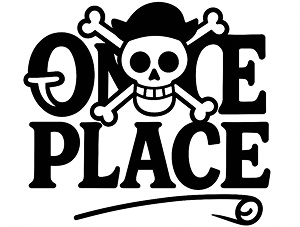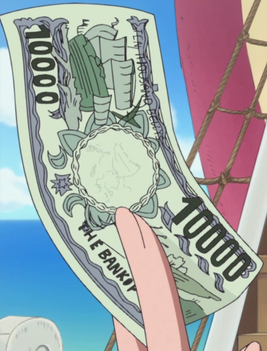Usaguchi Hideo
| Japanese Name | ベリー |
|---|---|
| Romanized Name | Berī |
| Official English Name | Berry |
| First Appearance | Chapter 1; Episode 4 (mentioned) Chapter 69; Episode 31 (shown) |
Introduction
The Belly, commonly represented as (a Latin lowercase esh superimposed over a capital B), is the world's main monetary unit. The Belly, commonly represented as (a Latin lowercase esh superimposed over a capital B), is the world's main monetary unit.
Overview
Belly are currently known to exist in six coin denominations and three paper denominations, with no further fractional units. These denominations are as follows: Coin: 1, 5, 10, 50, 100, and 500 Paper: 1,000, 5,000, and 10,000 Each of the paper denominations depicts a different personage: Usaguchi Hideo (ウサグチヒデヨ?, VIZ: "Rabbitmouth Hideyo") on the 1,000 note, Kumaguchi Ichiro (クマグチイチロー?, VIZ: "Bearmouth Ichiro") on the 5,000 note, and Gaikotsu Yukichi (ガイコツユキチ?, VIZ: "Skeleton Yukichi") on the 10,000 note. It is unknown if these are actual individuals or fictitious icons. Belly is apparently payable in check form, indicating reliable institutional backing. Per the written bounty on Dorry and Brogy's joint wanted poster, it has existed in circulation for over one hundred years.
Distribution
When Oda discussed the Doskoi Panda brand, he mentioned that the line was very expensive. With this in mind, to properly put the currency's value in a real-world context, a 10,000 shirt is expensive to the people of the One Piece world. Bell-mère was noted to be too poor to give her daughters everything they needed in life, and when Arlong invaded she had only a life's savings totaling at the time just 100,000 and had prior to this often been on a diet of just oranges to pay for the life she had to offer her daughters. She was the only one in her village unable to pay the full amount Arlong requested at the time of his arrival (100,000 per adult, 50,000 per child), and Arlong continued to demand this amount regularly from the residents of Cocoyasi Village resulting in years of struggle to pay the amount to avoid anyone being killed by Arlong. Arlong had agreed with Nami that she only had to bring 100,000,000 to buy her village back off him, an amount she took 8 years to amass and almost succeeded in reaching the goal simply by robbing pirates knowing they had access to more wealth than citizens.
Notably, also, Nami once demanded 1,000,000,000 from Igaram to protect his country's princess calling it a "measly" sum for a royal household to have, but later it was noted that the country did not even have this amount of wealth to offer as it was on the verge of civil war. The Straw Hat Pirates considered themselves "wealthy" after gaining gold worth 300,000,000. When they lost 200,000,000 of it to the Franky Family they noted their remaining 100,000,000 was still enough to buy a decent second-hand ship to continue their journey, even though their original amount would have bought them a brand new ship of much better quality (though Franky later used that very stolen 200,000,000 to build the crew a ship of great quality). The most affordable slaves are humans at 500,000 while 70,000,000 for a female unsplit mermaid is the highest starting bid for any race. As such, all kidnapping groups seek them out and they present the most profitable slaves at auctions, and the storyline hints they can run well into the 100,000,000s, being noted only to be bought by only the wealthiest of the One Piece world inhabitants.
Rare Adam Wood, being sold on the black market can reach the price of about 200,000,000. However, to a World Noble, a bid of 500,000,000 seems to be an insignificant amount of money to them judging by the way Saint Charlos bid in the Human Auctioning House. And most noteworthy, he bid this amount off the mark and no one else could counter it, ending the sale of Camie then and there. His father merely noted this as a 'waste of money', implying they have even more wealth and do not go through the same scale of financial concerns as the rest of the world. Their income appears to be the result of taxes that kingdoms affiliated with the World Government are required to pay, collectively known as the Heavenly Tribute.
Depending on the wealth of a nation, paying those tributes can range from trivial to nearly impossible, with poorer countries possibly suffering of famine as a result. While the limit of bounties is unknown, the highest known bounty belongs to Gol D. Roger, whose total bounty before his death was 5,564,800,000. The Ope Ope no Mi, considered the "Ultimate Devil Fruit" due to its medical potential and ability to grant eternal life, is so valuable that the Marines were willing to pay as much as 5,000,000,000 for it, showing that the World Government is willing to and capable of affording such prices. Donquixote Doflamingo offered to sell Riku Doldo III the rights to rule Dressrosa for 10,000,000,000, in lieu for taking the country by force; Riku stated such a ransom is impossible to acquire by the Dressrosa kingdom alone and Doflamingo had no intention to let him go and moved onto taking over the country anyways. According to Nico Robin, the value and purchasing power of belly has been reduced over at least the last century due to economic inflation. This was shown when Dorry and Brogy's bounties were re-issued after a century with the reward multiplying by 18 from 100,000,000 to 1,800,000,000. However, it is not certain that the worth of belly was exactly 18 times greater a century ago, given that the giants' bounties could have been raised due to their present-day actions after inflation was accounted for.
Prices
Genzo's pinwheel: 50 One Newspaper copy: 100 One cabbage: 150 Davy Back Fight's cotton candy: 500 Bon Chari: 500 for rental, 10,000 for purchase. Foxy's Exclusive Pin Badge: 800 (stated to be overpriced; a normal pin badge would cost around 300) Franky's "battle underpants": 880 Yagara Bull (for two people): 1,000 for rental Doskoi Panda brand shirt: 10,000 A full course meal at Baratie (for one person): 13,000 Nami's jacket: 28,800 Swords Lowest quality sword: 50,000 The sword Sandai Kitetsu: 1,000,000 The sword Wado Ichimonji: at least 10,000,000 Log Pose: 100,000 Devil Fruits: 100,000,000 (Average) Ope Ope no Mi: 5,000,000,000 Hachi's Takoyaki: 500 per serving Second-hand Ship: 100,000,000 New Ship: 300,000,000+ Rare Adam Wood: Roughly 200,000,000 (at black market rates) Bounties: Range from 50 for "pets" to well over 5,564,800,000 for top-priority criminals. Slaves Humans: 500,000+ Female Merfolk: 70,000,000+ Information on Lunarian whereabouts: 100,000,000 Monkey D. Luffy's logbook: 571 Roronoa Zoro's logbook: 667 Nami's logbook: 6,953 Usopp/Sogeking's logbook: 476 Sanji's logbook: 2,800 for men, free for women Tony Tony Chopper's logbook: 300 Nico Robin's logbook: 1,430 Franky's logbook: 3,900 A Corazon-themed onigiri, made by Law: 795 A bottle of ramune: 150 New Genesis fan: 1,000 Uta can badge: 600 Cyalume glow stick: 1,000 New Genesis t-shirt: 4,000 New Genesis tote bag: 3,000 Uta patches (set of 3): 1,500 Hair ribbon: 2,000 Bangles (set of 2): 1,000 Uta's headphones (wireless): 59,800 (adult-size) or 14,800 (child-size)
Other Currencies
Although the belly is a universal currency accepted nearly worldwide, a few isolated societies use different currencies: Extol (エクストル, Ekusutoru?) is the currency used in Skypiea. Normally, it is written similar to the Belly with an "esh": only with an "E" instead of a "B": . The extol seems to be pegged to the belly, as there are 10,000 per 1. It is implied that there are a number of inhabited sky islands that use extol, as Gan Fall, who believed the Straw Hats reached Skypiea via cloud hopping, assumed they were already familiar with the currency. Gor (ゴル, Goru?) is used on Amazon Lily.
Nothing else is known about it. Gold (金(きん), Kin?) is used in Wano Country. 500 gold is considered to be a hefty price. Nothing else is known about it. Platinum (白金(はっきん), Hakkin?) is another currency used in Wano.
One coin is apparently enough to build a whole house. Silver (銀(ぎん), Gin?) is a third currency used in Wano. It is least valuable of the Wano currencies, and is used for smaller transactions. A shopkeeper was selling small pots for 30 silver and a large pot for 60 silver. In the Boss Luffy specials, the currency ryo-belly (両ベリー, Ryō Berī?) is used. This currency has no banknotes, only coins, and mirrors the Tokugawa coinage that was used in real-life Edo Japan. Wanted! (Eiichiro Oda's earliest published work) features a currency denoted by two vertical lines over a Z. Nothing else is known about it, though it should be noted that the Z sign is basically identical to that of Dragon Ball's "Zeni" currency.
Gallery
Inspirations And Influences
In both denomination and appearance, the belly is an almost one-to-one parody of the modern Japanese yen. The banknote personages, in particular, spoof the historical figures on yen notes: Usaguchi Hideo combines the ¥1,000's Noguchi Hideyo with the term for "rabbit" (ウサ, Usa?). Kumaguchi Ichiro combines the ¥5,000's Higuchi Ichiyō with the term for "bear" (クマ, Kuma?) Gaikotsu Yukichi combines the ¥10,000's Fukuzawa Yukichi with the term for "skeleton" (ガイコツ, Gaikotsu?).
Translation And Dub Issues
Due to the fickleness of rendering katakana, different translators have romanized ベリー in many different ways: Belly is the most direct romanization seen in the original manga and correspondingly treated as the canonical spelling by this wiki. Beli or Beri are the most commonly used by fans, though Berri and Belly are not uncommon. Berry (plural Berries) is universal among the 4Kids, VIZ, and Funimation translations, as well as the live-action adaptation. The live action adaptation treats Berry as a mass noun, in that it lacks a plural form. The Odex dub alternates between using Berry (plural Berry) and dollars depending on the episode. Disagreement also exists on what plural marker—if any—applies to the term, as plural markers are largely unknown in the Japanese language.
Trivia
Some characters—particularly Nami—adopt symbols in their eyes when demonstrating extreme greed. This is a common artistic convention across many comic books and cartoons, though some have implied it might be an actual, physical transformation. Due to its inspiration, some fans treat the Belly as completely equivalent to the yen in purchasing power, e.g. assuming a 10,000 note would be worth ¥10,000 (approx. 64.60 USD circa 2025) of comparable real-life goods. The in-story accuracy of this idea remains unclear, though it is embraced by Shueisha's licensed Mugiwara Stores, where "¥1 = 1" signs are posted on cash registers and cashiers state purchase totals in Belly (though all price tags still display standard yen). The Belly's symbol closely resembles the Thai baht: ฿ (baht) / (belly). In the One Piece game, One Piece: Pirate Warriors 2, it is said that the largest bill comes worth 10,000 belly. Gild Tesoro's non-canon wealth amounted to 20% of the world's belly supply, and was famous enough to be known as the "Tesoro Money" (テゾーロマネー, Tezōro Manē?, Funimation: "Tesoro Stash"). In his primary vault alone, Tesoro held 500,000,000,000, the largest sum of money mentioned in the series and, according to Robin, enough to buy a small country.
References
External Links
Wikipedia on the Japanese yen Wikipedia on yen personages

